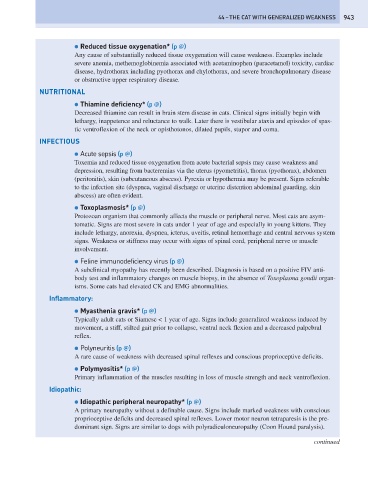Page 951 - Problem-Based Feline Medicine
P. 951
44 – THE CAT WITH GENERALIZED WEAKNESS 943
● Reduced tissue oxygenation* (p @)
Any cause of substantially reduced tissue oxygenation will cause weakness. Examples include
severe anemia, methemoglobinemia associated with acetaminophen (paracetamol) toxicity, cardiac
disease, hydrothorax including pyothorax and chylothorax, and severe bronchopulmonary disease
or obstructive upper respiratory disease.
NUTRITIONAL
● Thiamine deficiency* (p @)
Decreased thiamine can result in brain stem disease in cats. Clinical signs initially begin with
lethargy, inappetence and reluctance to walk. Later there is vestibular ataxia and episodes of spas-
tic ventroflexion of the neck or opisthotonos, dilated pupils, stupor and coma.
INFECTIOUS
● Acute sepsis (p @)
Toxemia and reduced tissue oxygenation from acute bacterial sepsis may cause weakness and
depression, resulting from bacteremias via the uterus (pyometritis), thorax (pyothorax), abdomen
(peritonitis), skin (subcutaneous abscess). Pyrexia or hypothermia may be present. Signs referable
to the infection site (dyspnea, vaginal discharge or uterine distention abdominal guarding, skin
abscess) are often evident.
● Toxoplasmosis* (p @)
Protozoan organism that commonly affects the muscle or peripheral nerve. Most cats are asym-
tomatic. Signs are most severe in cats under 1 year of age and especially in young kittens. They
include lethargy, anorexia, dyspnea, icterus, uveitis, retinal hemorrhage and central nervous system
signs. Weakness or stiffness may occur with signs of spinal cord, peripheral nerve or muscle
involvement.
● Feline immunodeficiency virus (p @)
A subclinical myopathy has recently been described. Diagnosis is based on a positive FIV anti-
body test and inflammatory changes on muscle biopsy, in the absence of Toxoplasma gondii organ-
isms. Some cats had elevated CK and EMG abnormalities.
Inflammatory:
● Myasthenia gravis* (p @)
Typically adult cats or Siamese < 1 year of age. Signs include generalized weakness induced by
movement, a stiff, stilted gait prior to collapse, ventral neck flexion and a decreased palpebral
reflex.
● Polyneuritis (p @)
A rare cause of weakness with decreased spinal reflexes and conscious proprioceptive deficits.
● Polymyositis* (p @)
Primary inflammation of the muscles resulting in loss of muscle strength and neck ventroflexion.
Idiopathic:
● Idiopathic peripheral neuropathy* (p @)
A primary neuropathy without a definable cause. Signs include marked weakness with conscious
proprioceptive deficits and decreased spinal reflexes. Lower motor neuron tetraparesis is the pre-
dominant sign. Signs are similar to dogs with polyradiculoneuropathy (Coon Hound paralysis).
continued

